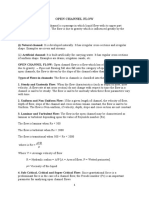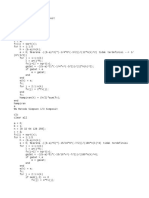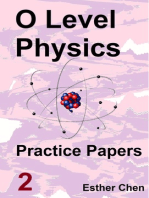Tutorial 3 Deflection
Uploaded by
AbelBayartTutorial 3 Deflection
Uploaded by
AbelBayartTutorial 3: Deflection of Beams
1. Both of the beams shown below has a constant cross-section, and the weight of the beam
itself can be ignored (i.e. it’s small with respect to the size of the applied loads).
For both questions
• use Macaulay step functions to write an expression for the bending moment (M) in the
entire beam as a function of x (the distance along the beam from the left-hand end);
• differentiate the expression to obtain the shear force (Q) as a function of x;
• for each ‘section’ of the beam (i.e. where there is a change in loading) draw a free
body diagram and write the expression for M and Q in that section. Check your
answers by comparing it with Tutorial 1 Q5 and Q6.
(a)
30kN 50kN
3m 2m 4m
(b)
10kN/m 20kN 30kN
3m 2m 3m 1m
2. For question 1(b), integrate the expression for bending moment (M) to obtain the beam
deflection as a function of x. Plot the deflection using a graphics program such as Excel,
Maple or Matlab.
3. A horizontal beam is subjected to the loading shown below. Calculate the beam deflection
under the 8 kN force. The bending stiffness (or flexural rigidity) EI of the beam is 1 MNm2.
(4.92 mm)
2 kN 6 kN/m 8 kN
1m 3m 1m
Prof. Andrew Moore, Heriot-Watt University
4. A simply supported beam of length 2 m has a point load applied to it at a distance 1.6 m
from the left-hand end. Worked example 5 showed that the deflection is given by:
− EIv = 0.2 x 3 − [x − 1.6] − 0.768 x
3
Determine an expression for the position of the maximum deflection. Use the fact that the
maximum deflection occurs in the longest section of the beam to obtain your answer. Hence
calculate the maximum deflection of the beam.
6 kN (1.13 m, 0.579/EI)
1.6 m
2m
Statically indeterminate beams
5. Inspect the beams below and state whether they are statically determinate or indeterminate,
assuming that the applied loads W and w/unit length are known. No calculation is required!
(a) W W (b) W W (c)
W
(d) (e) w / unit length
W W
L/2 L/2
Prof. Andrew Moore, Heriot-Watt University
6. A propped cantilever is loaded with a uniformly distributed load as shown in the figure
below. It has a constant cross section and the weight of the beam is included in the UDL.
Calculate the reactions and moments at the supports.
[15kN, 25kN, -20kNm]
Sketch the bending moment distribution along the beam (i.e. you DO NOT need to use graph
paper). Mark important values on the graph, including labels for the axes and the values of
bending moment at the beam ends.
Evaluate dM/dx for the beam, and calculate the position and value of the local maximum
bending moment. Also calculate the location of the point of contraflexure (where the bending
moment is zero and changes sign).
[1.5m, 11.25kNm, 3m]
10kN/m
4m
7. A steel girder (E=200 GN/m2) has a weight that can be approximated by a UDL of 1 kN/m
and acts as a rail for an overhead crane of weight 50 kN. The rail is 20 m long, is built in at
both ends and has a constant cross-section with the dimensions (in mm) shown in the figure.
Calculate the reactions and moments at the supports.
[15.2kN, -65.33kNm, 54.8kN, -161.33kNm]
For the position of the crane shown, calculate the position and value of the maximum bending
moment (assume that it occurs in the first section of the beam i.e. at x < 16 m, before the load
W). Determine the maximum longitudinal stress σx in the beam at this point, and determine if
it exceeds the material yield stress of 350 MN/m2.
[15.2 m, 50.19 kNm, 25.45 MN/m2]
Sketch the bending moment distribution along the beam (i.e. you DO NOT need to use graph
paper). Mark important values on the graph, including labels for the axes and the values of
bending moment at the beam ends and at the discontinuities in the beam loading.
20
50 kN
16m
1 kN/m
467
11.5
20 m 20
mm 193
Prof. Andrew Moore, Heriot-Watt University
8. A built-in misaligned beam is loaded with a uniformly distributed load as shown in the
figure below. It has a constant cross section and the weight of the beam is included in the
UDL. For the beam section, EI=1 MNm2. Calculate the reactions and moments at the
supports.
[7.5kN, -5.5kNm, -1.5kN, 3.5kNm]
Demonstrate that your solution is correct by comparing it with Worked examples 1 and 3 (an
example of the so-called superposition principle).
3 kN/m
3 mm
2m
9. The propped cantilever shown below is made of steel (E=200 GN/m2) and has a constant
rectangular cross-section of depth, D and width D/2 (where D=26.34mm). Calculate the
reactions and moments at the supports.
[1.33kN, 1.67kN, -0.47kNm]
Calculate the position and value of the maximum deflection of the beam (assume that it
occurs in the longest section of the beam i.e. at x > 0.4 m, after the load W).
[0.44m, 9.1mm]
3 kN
3 mm
0.4 m
1m
Prof. Andrew Moore, Heriot-Watt University
You might also like
- Philippine Public Fiscal Administration Leonor Magtolis Briones PDF67% (24)Philippine Public Fiscal Administration Leonor Magtolis Briones PDF1 page
- Eyoyo BT 2D Barcode Scanner. User Manual. Model - Youtube67% (3)Eyoyo BT 2D Barcode Scanner. User Manual. Model - Youtube36 pages
- Three Point Bending Test Research of Carbon FibreNo ratings yetThree Point Bending Test Research of Carbon Fibre3 pages
- Question Yyybank For Unit I of MechatronicsNo ratings yetQuestion Yyybank For Unit I of Mechatronics3 pages
- Project Mechanic of Material by Using Mac Caulay MethodNo ratings yetProject Mechanic of Material by Using Mac Caulay Method29 pages
- Civl2201 2018 Laboratory Bending Channel Feedback PDFNo ratings yetCivl2201 2018 Laboratory Bending Channel Feedback PDF12 pages
- 05 Question Bank Fo RMV Unit V Continuous Systems 06 05 2018 Additional PDF0% (1)05 Question Bank Fo RMV Unit V Continuous Systems 06 05 2018 Additional PDF4 pages
- JJ310 STRENGTH OF MATERIAL Chapter 5 (A) Beam Deflection100% (1)JJ310 STRENGTH OF MATERIAL Chapter 5 (A) Beam Deflection20 pages
- Hydroforming: Presented By: Byron Erath Duane EllsworthNo ratings yetHydroforming: Presented By: Byron Erath Duane Ellsworth17 pages
- Download Study Resources for Engineering Fluid Mechanics 11th Edition Elger Solutions Manual100% (6)Download Study Resources for Engineering Fluid Mechanics 11th Edition Elger Solutions Manual70 pages
- Laspotech Lecture I On Hydraulic and Hydrology-1No ratings yetLaspotech Lecture I On Hydraulic and Hydrology-17 pages
- EN123 Lab 2 Getting Acquainted With Analog Circuit Components Part 1 - Resistance, Capacitance & DiodeNo ratings yetEN123 Lab 2 Getting Acquainted With Analog Circuit Components Part 1 - Resistance, Capacitance & Diode6 pages
- Me16A: Chapter Three: Bending Moments and Shearing Forces in BeamsNo ratings yetMe16A: Chapter Three: Bending Moments and Shearing Forces in Beams68 pages
- Experiments - SOM Strength of Materials Lab ExperimentsNo ratings yetExperiments - SOM Strength of Materials Lab Experiments38 pages
- Fluid Mechanics Lectures and Tutorials 30: Abs Atm GageNo ratings yetFluid Mechanics Lectures and Tutorials 30: Abs Atm Gage11 pages
- Maximum Distortion Energy Theory or Von Mises CriteriaNo ratings yetMaximum Distortion Energy Theory or Von Mises Criteria2 pages
- Lab 4 Mechanical Testing Tensile and Torsional TestingNo ratings yetLab 4 Mechanical Testing Tensile and Torsional Testing8 pages
- Green Mechanic - Deflection of Beam Lab ReportNo ratings yetGreen Mechanic - Deflection of Beam Lab Report7 pages
- SA Model Paper Solutions - III SemesterNo ratings yetSA Model Paper Solutions - III Semester23 pages
- Sensors: Figure1: Improved Bin E With Automated Wheels and SensorsNo ratings yetSensors: Figure1: Improved Bin E With Automated Wheels and Sensors2 pages
- Scaffolding: Al Hidaya Metal Works L.L.CNo ratings yetScaffolding: Al Hidaya Metal Works L.L.C57 pages
- Byte Con Fiden Tial Don Otc Opy: Model Name: Ga-H110M-S2HNo ratings yetByte Con Fiden Tial Don Otc Opy: Model Name: Ga-H110M-S2H50 pages
- U.S. E T, A RFQ PR9037551: Mbassy Irana LbaniaNo ratings yetU.S. E T, A RFQ PR9037551: Mbassy Irana Lbania49 pages
- Hong Kong Marriage and Family Therapy Association Limited: Name of Applicant: (English) ( )No ratings yetHong Kong Marriage and Family Therapy Association Limited: Name of Applicant: (English) ( )10 pages
- Declaration - 21203621 - 12 - 6 - 2020 10 - 08 - 35 PMNo ratings yetDeclaration - 21203621 - 12 - 6 - 2020 10 - 08 - 35 PM1 page
- Choong-Sik Chung - Developing Digital Governance - South Korea As A Global Digital Government Leader-Routledge (2020) - RemovedNo ratings yetChoong-Sik Chung - Developing Digital Governance - South Korea As A Global Digital Government Leader-Routledge (2020) - Removed13 pages
- Magnetic Piston Operated Engine: Sumit Dhangar, Ajinkya Korane, Durgesh BarveNo ratings yetMagnetic Piston Operated Engine: Sumit Dhangar, Ajinkya Korane, Durgesh Barve7 pages
- Orange and Violet Illustration Class Syllabus Education PresentationNo ratings yetOrange and Violet Illustration Class Syllabus Education Presentation5 pages
- Isolation Precautions and Use of Personal Protective Equipments1No ratings yetIsolation Precautions and Use of Personal Protective Equipments165 pages
- R&D Update - Edge Fracture in Hole Extrusion and Flanging, Part II - The FabricatorNo ratings yetR&D Update - Edge Fracture in Hole Extrusion and Flanging, Part II - The Fabricator9 pages
- Philippine Public Fiscal Administration Leonor Magtolis Briones PDFPhilippine Public Fiscal Administration Leonor Magtolis Briones PDF
- Eyoyo BT 2D Barcode Scanner. User Manual. Model - YoutubeEyoyo BT 2D Barcode Scanner. User Manual. Model - Youtube
- Project Mechanic of Material by Using Mac Caulay MethodProject Mechanic of Material by Using Mac Caulay Method
- Civl2201 2018 Laboratory Bending Channel Feedback PDFCivl2201 2018 Laboratory Bending Channel Feedback PDF
- 05 Question Bank Fo RMV Unit V Continuous Systems 06 05 2018 Additional PDF05 Question Bank Fo RMV Unit V Continuous Systems 06 05 2018 Additional PDF
- JJ310 STRENGTH OF MATERIAL Chapter 5 (A) Beam DeflectionJJ310 STRENGTH OF MATERIAL Chapter 5 (A) Beam Deflection
- Hydroforming: Presented By: Byron Erath Duane EllsworthHydroforming: Presented By: Byron Erath Duane Ellsworth
- Download Study Resources for Engineering Fluid Mechanics 11th Edition Elger Solutions ManualDownload Study Resources for Engineering Fluid Mechanics 11th Edition Elger Solutions Manual
- EN123 Lab 2 Getting Acquainted With Analog Circuit Components Part 1 - Resistance, Capacitance & DiodeEN123 Lab 2 Getting Acquainted With Analog Circuit Components Part 1 - Resistance, Capacitance & Diode
- Me16A: Chapter Three: Bending Moments and Shearing Forces in BeamsMe16A: Chapter Three: Bending Moments and Shearing Forces in Beams
- Experiments - SOM Strength of Materials Lab ExperimentsExperiments - SOM Strength of Materials Lab Experiments
- Fluid Mechanics Lectures and Tutorials 30: Abs Atm GageFluid Mechanics Lectures and Tutorials 30: Abs Atm Gage
- Maximum Distortion Energy Theory or Von Mises CriteriaMaximum Distortion Energy Theory or Von Mises Criteria
- Lab 4 Mechanical Testing Tensile and Torsional TestingLab 4 Mechanical Testing Tensile and Torsional Testing
- O level Physics Questions And Answer Practice Papers 2From EverandO level Physics Questions And Answer Practice Papers 2
- Sensors: Figure1: Improved Bin E With Automated Wheels and SensorsSensors: Figure1: Improved Bin E With Automated Wheels and Sensors
- Byte Con Fiden Tial Don Otc Opy: Model Name: Ga-H110M-S2HByte Con Fiden Tial Don Otc Opy: Model Name: Ga-H110M-S2H
- Hong Kong Marriage and Family Therapy Association Limited: Name of Applicant: (English) ( )Hong Kong Marriage and Family Therapy Association Limited: Name of Applicant: (English) ( )
- Declaration - 21203621 - 12 - 6 - 2020 10 - 08 - 35 PMDeclaration - 21203621 - 12 - 6 - 2020 10 - 08 - 35 PM
- Choong-Sik Chung - Developing Digital Governance - South Korea As A Global Digital Government Leader-Routledge (2020) - RemovedChoong-Sik Chung - Developing Digital Governance - South Korea As A Global Digital Government Leader-Routledge (2020) - Removed
- Magnetic Piston Operated Engine: Sumit Dhangar, Ajinkya Korane, Durgesh BarveMagnetic Piston Operated Engine: Sumit Dhangar, Ajinkya Korane, Durgesh Barve
- Orange and Violet Illustration Class Syllabus Education PresentationOrange and Violet Illustration Class Syllabus Education Presentation
- Isolation Precautions and Use of Personal Protective Equipments1Isolation Precautions and Use of Personal Protective Equipments1
- R&D Update - Edge Fracture in Hole Extrusion and Flanging, Part II - The FabricatorR&D Update - Edge Fracture in Hole Extrusion and Flanging, Part II - The Fabricator


































































































